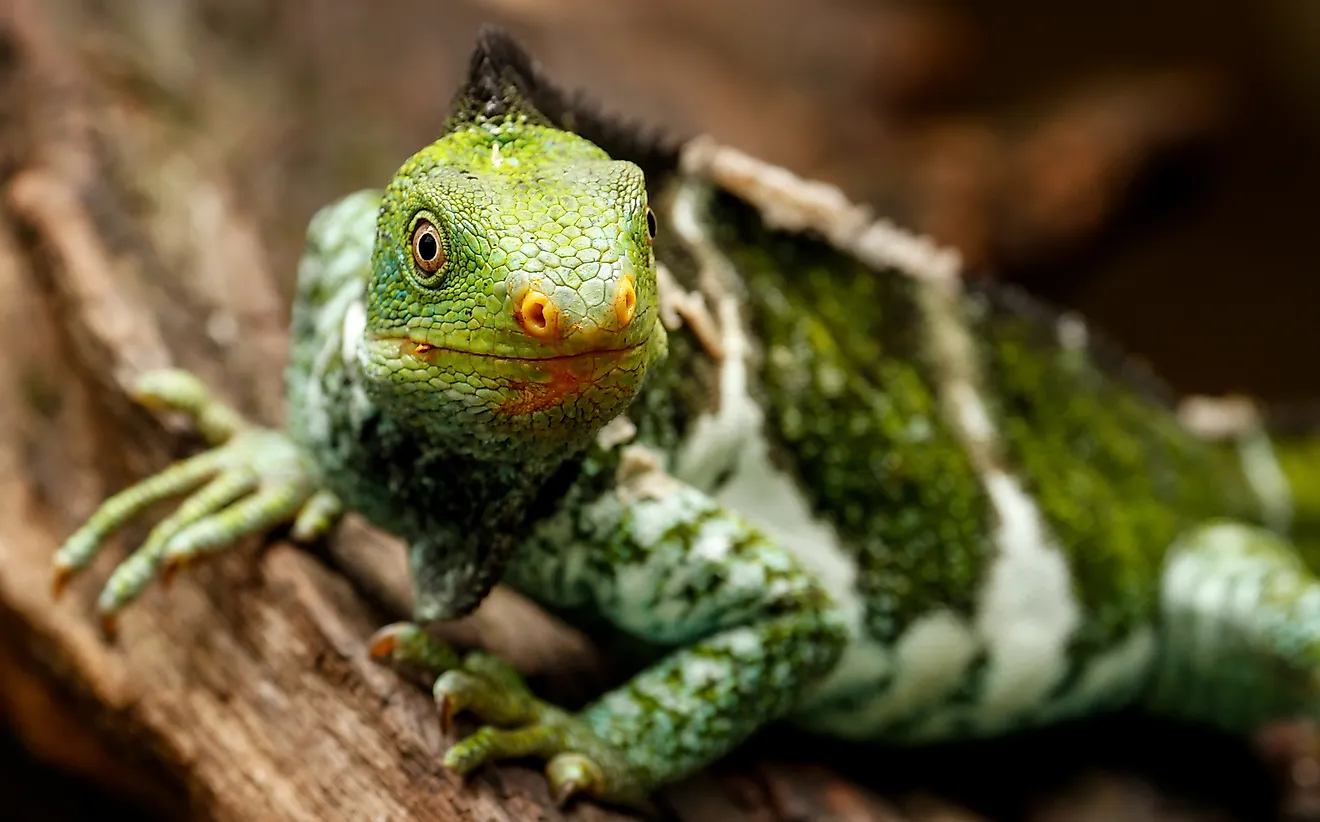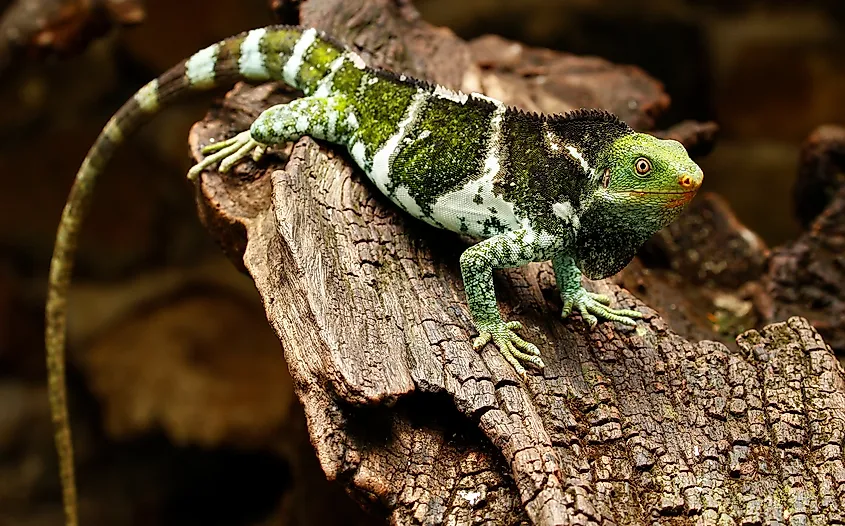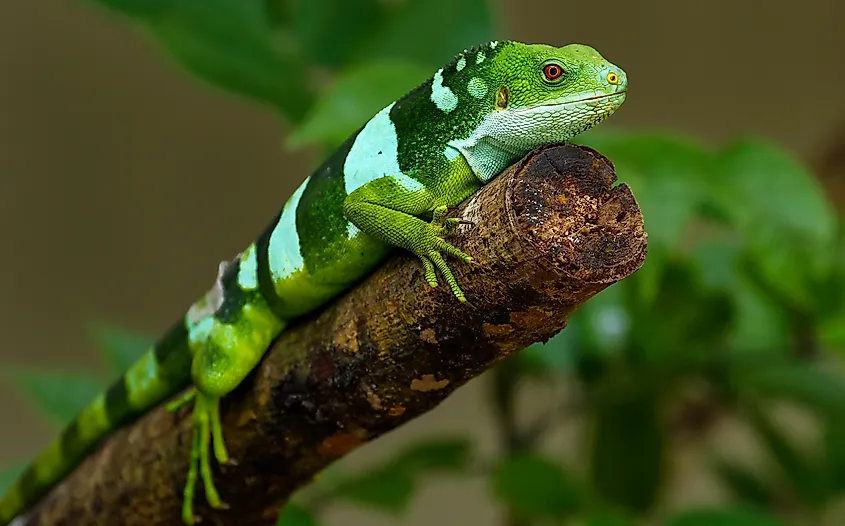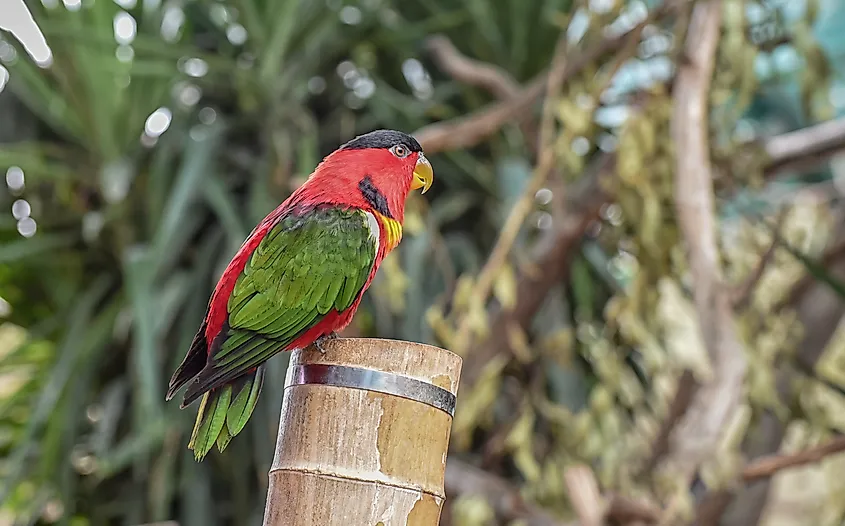8 Animals Found In Fiji

Fiji is an island nation located in the Pacific Ocean that occupies an area of 7,056 sq mi and had an estimated population of more than 900,000 in 2018. The country is an archipelago of 332 islands, although the two largest, Vanua Levu and Viti Levu, are homes to 87% of Fiji’s total population.
Suva is the country's capital and largest city. Fijian, English, and Fiji Hindi are Fiji's official languages, while the Fijian dollar is the country's currency. Fiji’s closest neighbors are New Zealand, New Caledonia, Tonga, the Samoas, Tuvalu, and France’s Wallis and Futuna. The country experiences a tropical marine climate, with warm temperatures throughout the year. Some of the various animals that inhabit Fiji's islands are listed below.
Fiji Crested Iguana

The Fiji crested iguana (Brachylophus vitiensis) inhabits the northwestern islands of Fiji. Its skin is green with white stripes, and it measures approximately 75cm in length and weighs 300 g. The species has one of the longest incubation periods among reptiles, which lasts eight months. The Fiji crested iguana was first identified by Dr. John Gibbons, who travelled to Fiji in search of the iguana after observing it in a screening of the film The Blue Lagoon. Gibbons named the animal vitiensis, meaning "Fiji" in Latin. The Fiji crested iguana changes its color from green to black when aroused or threatened, and feeds on the leaves, fruits, shoots, and flowers of trees and shrubs. The species is listed as "Critically Endangered" (CR) on the International Union for Conservation of Nature's (IUCN) Red List.
Fiji Banded Iguana

The Fiji banded iguana (Brachylophus fasciatus) is an arboreal species of lizard endemic to some of Fiji's southeastern islands. It is considered a national treasure and has been featured on postage stamps, currency, and even phone book covers. Males are emerald green while females are solid green in color.Both sexes have a yellow underside and can grow up to a length of 60 cm. The Fiji banded iguana weighs 200 g and consume leaves, fruits, flowers, and shrubs. Its population has declined due to habitat destruction, and more significantly, the introduction of mongoose and house cats to the islands.
Fijian Monkey-Faced Bat
The Fijian monkey-faced bat (Mirimiri acrodonta) is also known as the Fijian flying fox. It is Fiji's only endemic mammal and was discovered on the island of Taveuni by William and Ruth Beckon in 1976. The bat weighs between 222 and 362 g, and its forearms measure 120 mm. The eyes of the Fijian monkey-faced bat are distinctly orange in color, and wings are attached to its body near the spine. The species is difficult to capture, and therefore only six individuals have ever been observed. The Fijian monkey-faced bat is listed as a species in imminent danger of extinction by the Alliance for Zero Extinction.
Fiji Petrel
The Fiji petrel (Pseudobulweria macgillivrayi), also known as MacGillivray's petrel, is a small, dark petrel. The bird is 30 cm long, with dark, chocolate-colored feathers, and pale blue foot patches. The petrel is featured on a Fijian banknote, as well as the now-defunct Air Fiji. The Fiji petrel is protected under Fijian law. It is also quite rare, resulting in a lack of ecological information regarding the animal. In May 2009, the first photographs of the bird at sea were taken approximately 25 nautical miles south of Gau Island.
Orange Fruit Dove
The orange fruit dove (Ptilinopus victor), also known as the flame dove, grows to approximately 20 cm in length and is short-tailed. Males have golden olive heads and elongated bright orange "hair-like" body feathers, while females possess blackish tails and orange-yellow under tail coverts. Young orange fruit doves resemble females. The orange dove is endemic to forests on the islands of Vanua Levu, Taveuni, Rabi, and Laucala. Its diet mainly consists of small fruits, berries, caterpillars, and insects. The orange fruit dove is closely related to the whistling fruit dove and the golden fruit dove. These species of birds are allopatric, meaning they do not share the same habitat in any location.
Fijian Ground Frog
The Fijian ground frog (Platymantis vitianus) is, as its name suggests, a ground-dwelling frog. The size of its body ranges from 8 mm as a hatchling to a length of 110 mm as an adult. The frog’s skin color is variable, with its back ranging from dark brown to brick red. Fijian ground frogs are nocturnal and prey on insects. The species is threatened by the destruction of its breeding sites through deforestation. Additionally, Fijian ground frogs are preyed upon by introduced mammals such as the small Indian mongoose, rats, and feral cats.
Red-Throated Lorikeet

The red-throated lorikeet (Charmosyna amabilis) is a critically endangered lorikeet endemic to Fiji. It is 18 cm in length and is generally bright green in color, with red cheeks, throat, and thighs. The bird is believed to inhabit the islands of Viti Levu, Taveuni, and Ovalau, although it is rarely spotted. The greatest threat to the red-throated lorikeet is habitat loss. Other threats include common predators like the black rat, as well as the introduced feral cats and small Indian mongooses.
Fiji Goshawk
The Fiji Goshawk (Accipiter rufitorques) is a bird of prey. It is endemic to Fiji, where it inhabits the larger islands of Gau, Viti Levu, Taveuni, Vanua Levu, and Ovalau. It occupies a range of wooded habitats, from natural rainforests to coconut plantations to parks. The Fiji goshawk ranges in size from 30–40 cm, and females are typically larger than males. The bird has long legs and a long tail, and feeds on birds as large as pigeons, as well as insects, rodents, and reptiles.











